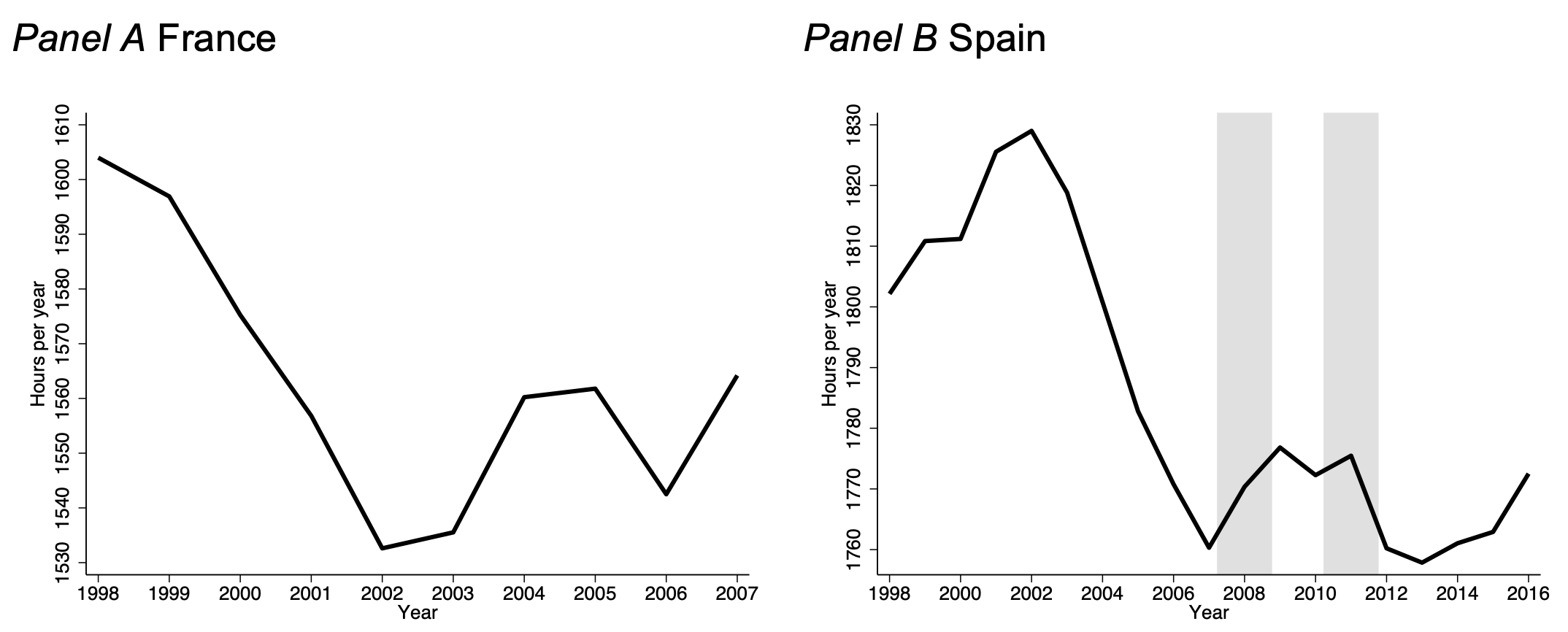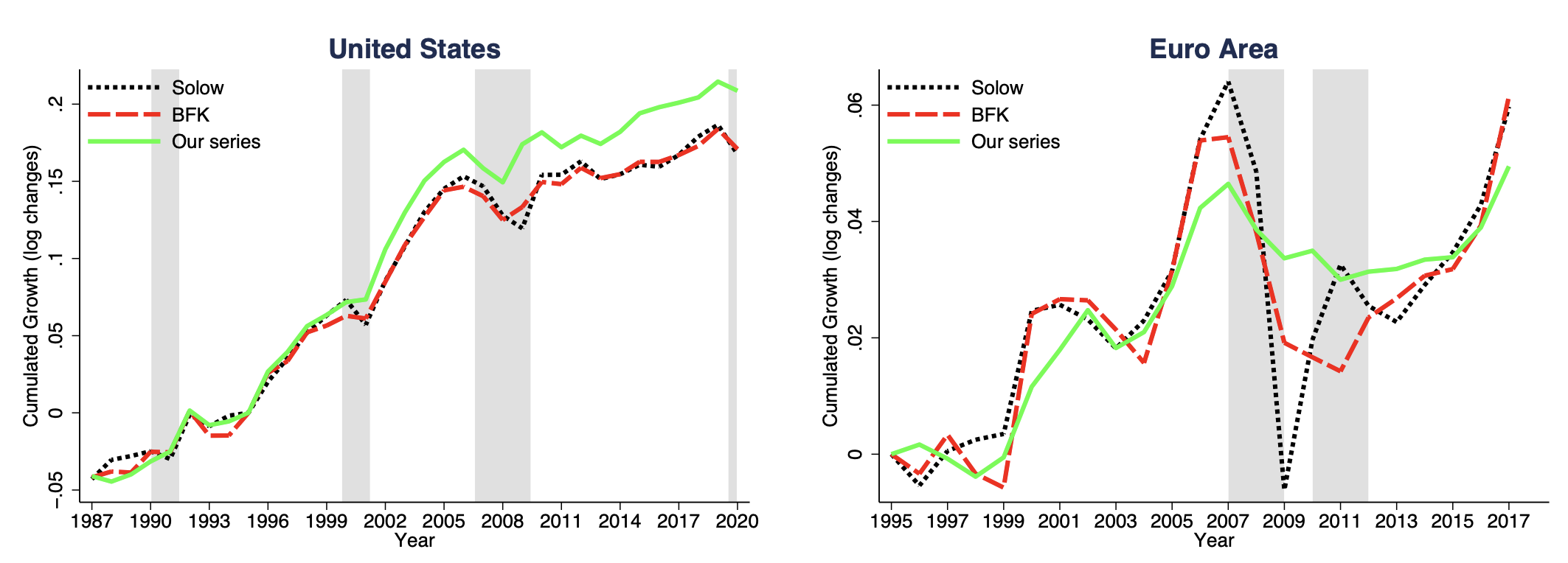Productivity growth is the main source of increasing living standards. Therefore, productivity developments are closely monitored by economists. For instance, the slowdown in productivity growth in most rich economies since the mid-2000s has spurred many debates and concerns (Sichel and Byrne 2017, Boppart and Li 2021). More recently, experts have debated how new working arrangements after the Covid-19 pandemic, with a greater role for work from home, will affect productivity (Hansen et al. 2023).
To have an informed debate on these issues, we need reliable measures of productivity growth. Modern productivity measures build on the work of several pioneers. Robert Solow (1957) defined total factor productivity (TFP) growth as the part of output growth that cannot be explained by growth in inputs. He showed that under perfect competition, TFP growth can be computed as the difference between output growth and a weighted average of input growth rates (where the weights are given by the ratio of spending on each input to total sales). These ‘Solow residuals’ are still the most common measure of productivity. Under the impetus of Dale Jorgenson, researchers in many countries have built datasets measuring TFP growth at the industry and at the aggregate level (Jorgenson et al. 1987, Inklaar et al. 2022).
However, Solow residuals ignore an important source of short-run dynamics: changes in factor utilisation. For instance, in a recession, workers typically perform less tasks per hour of work. As this fall in labour input is not recorded in standard datasets, their Solow residuals spuriously decrease during recessions. In a series of influential papers, Basu and Fernald (2001) and Basu et al. (2006) show that under some assumptions, changes in hours per worker are one-to-one related to changes in factor utilisation. Thus, changes in hours per worker can be used to proxy utilisation and to construct a series for ‘utilisation-adjusted’ TFP growth, which should be closer to capturing true technological progress.
In a recent paper (Comin et al. 2023), we build on these insights to propose further improvements to measures of TFP growth, with a particular focus on Europe.
We point out that while standard measures of TFP measurement have led to many important insights, they also rely on strong assumptions which might not always hold. First, Solow’s perfect competition assumption conflicts with recent empirical evidence indicating positive profits (e.g. Barkai 2020). This implies that different inputs should be weighted by their share in total costs rather than their share in total sales. Second, while hours per worker are an appropriate proxy for unobserved utilisation in the US, the case is less clear-cut in Europe.
We identify two potential problems, illustrated in Figure 1. Panel A shows hours per worker in France between 1998 and 2007. In the beginning of the period, a left-wing government introduced the 35-hour workweek, which became fully mandatory on 1 January 2002. However, later during the same year, a new right-wing government weakened the reform through several measures (e.g. a reduction in the cost of overtime work). Thus, changes in hours per worker in France during these years probably reflect changes in the relative cost of hours rather than changes in utilisation, and using hours as a utilisation proxy would not be appropriate.
Figure 1 Hours per worker in selected European countries
Panel B plots hours per worker in Spain, showing a decrease during the 2002-2007 boom and an increase in the 2008-2012 crisis. Thus, taking hours per worker as a utilisation proxy, one would conclude that Spanish factor utilisation decreased in the boom and increased in the crisis, which seems implausible and is out of line with all other measured inputs. In our paper, we argue that the behaviour of Spanish hours per worker can instead be explained at least in part by composition effects between workers with temporary and permanent contracts.
Given these limitations of the hours per worker proxy in a European context, we propose to instead rely on capacity utilisation surveys. In our paper, we argue that the change in a firm’s capacity utilisation rate can be understood as a weighted average of changes in variable inputs. Thus, simply put, while the standard Basu-Fernald-Kimball (BFK) approach uses one labour utilisation margin (hours per worker) as a proxy for unobserved utilisation, we instead use a summary statistic for variable inputs.
Using our method, we estimate profit and utilisation-adjusted annual TFP growth, at the industry and at the aggregate level, for the five largest European economies (between 1995 and 2018) and for the US (between 1988 and 2020). Precisely, we estimate industry-level annual TFP growth by running an instrumental variable regression of a modified Solow residual (weighting inputs with cost rather than sales shares) on changes in capacity utilisation. The residual from this regression is our measure of industry-level TFP growth.
Our results are strikingly different from the ones obtained by standard methods. Figure 2 plots our aggregate TFP series for the US and an aggregate of the four largest euro area countries, and Figure 3 plots TFP series for individual European countries.
Figure 2 Cumulated TFP growth in the US and in the euro area
In all five European countries, our TFP measures are less volatile than the Solow or Basu-Fernald-Kimball measures, and do not move as much with the business cycle. The differences between TFP series are most apparent during the Great Recession and the European sovereign debt crisis. In these years, the Solow and Basu-Fernald-Kimball methods suggest a dramatic decrease followed by a rapid recovery, while we find that TFP fell only slightly and gradually.
Figure 3 Cumulated TFP growth in European countries
Why are our TFP series different from the standard ones? First, taking into account positive profits leads to a lower weight for capital in the input mix. In countries in which capital grew more than other inputs (such as the UK or the US), this leads to an upward revision of long-run TFP growth. In countries in which capital grew less than other inputs (such as Germany), it instead leads to a downward revision. The change in the input weights also has cyclical implications. As capital fell less than other inputs during the 2008-2009 crisis, we attribute a greater fraction of the fall in output to inputs and less to TFP. This effect is strongest in Spain and Italy, where profits are high and the crisis was most severe.
Second, the capacity utilisation survey appears to be more successful at capturing variation in unobserved utilisation in Europe, resulting in a less volatile and less cyclical TFP series. Coming back to the two cases highlighted in Figure 1, in France, our series is substantially smoother than the Basu-Fernald-Kimball series (for which the changes in hours per worker in the early 2000s, induced by labour market reforms, create some spurious volatility). In Spain, the survey suggests a much larger utilisation adjustment (and therefore a smaller fall in TFP during the deep 2008-2012 crisis) than hours per worker. For the euro area as a whole, our baseline series is half as volatile as an alternative series obtained with the hours per worker proxy. Instead, in the US, using hours per worker or capacity utilisation surveys as proxies for unobserved factor utilisation makes essentially no difference, as both series are strongly correlated.
Finally, we use our insights from the annual data to build quarterly series for four European countries. Most European countries do not provide quarterly data for capital services. Therefore, with the exception of the UK, no European country currently provides any quarterly data on TFP growth (utilisation-adjusted or not). Our paper fills this important measurement gap. We construct a quarterly series for capital, relying on investment data from Eurostat, and use it to generate utilisation-adjusted estimates for quarterly TFP growth, as shown in Figure 4. These series provide an important new input for applied macroeconomic research on European data.
Figure 4 Quarterly TFP growth in Europe
We plan to continuously update both our annual and our quarterly series, and extend them to further countries. The data are posted on our websites.
Moreover, our approach is easy to implement for other researchers interested in these topics. Thus, we hope it can yield further insights into productivity developments around the world.
References
Barkai, S (2020), “Declining Labor and Capital Shares”, The Journal of Finance 75(5): 2421–2463.
Basu, S and J Fernald (2001), “Why Is Productivity Procyclical? Why Do We Care?”, In C R Hulten, E R Dean and M J Harper (eds.), New Developments in Productivity Analysis, University of Chicago Press, pp. 225–302.
Basu, S, J Fernald and M Kimball (2006), “Are Technology Improvements Contractionary?”, American Economic Review 96(5): 1418–1448.
Boppart, T and H Li (2021), “Productivity slowdown: reducing the measure of our ignorance”, CEPR Discussion Paper 16478.
Comin, D, J Quintana, T Schmitz and A Trigari (2023), “Revisiting Productivity Dynamics in Europe: A New Measure of Utilization-Adjusted TFP Growth”, CEPR Discussion Paper 15402.
Hansen, S, P Lambert, N Bloom, S Davis, R Sadun and B Taska (2023), “Remote Work across Jobs, Companies, and Space”, CEPR Discussion Paper 17964.
Inklaar, R, B Van Ark and J Fernald (2022), “Dale Jorgenson: Investment, growth accounting, and economic measurement”, Vox EU.org, 24 June.
Jorgenson, D, F M Gollop and B Fraumeni (1987), Productivity and U.S. Economic Growth, Harvard University Press.
Sichel, D and D Byrne (2017), “The productivity slowdown is even more puzzling than you think”, VoxEU.org, 22 August.
Solow, R (1957), “Technical Change and the Aggregate Production Function”, The Review of Economics and Statistics 39(3): 312–320.











